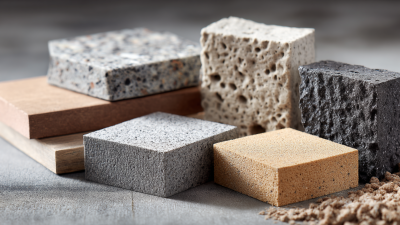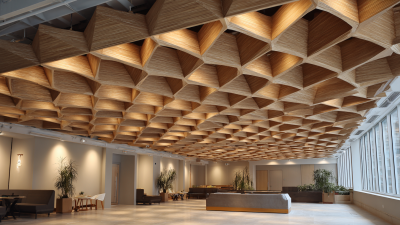Unlocking Silence: The Science Behind Soundproof Building Materials for a Quieter Home
In recent years, the demand for tranquil living environments has surged, as individuals increasingly recognize the importance of soundproofing in their homes. The growing awareness is underscored by a study from the National Institute of Building Sciences, which revealed that noise pollution can negatively impact mental health and productivity. Consequently, homeowners are turning to soundproof building materials as a practical solution to mitigate unwanted noise. These materials, including acoustic panels, specialized insulation, and resilient channels, play a pivotal role in enhancing the acoustic comfort of residential spaces. According to a report by the Acoustical Society of America, effective soundproofing can reduce perceived noise levels by up to 90%, creating a serene atmosphere vital for relaxation and concentration. As we delve into the science behind these innovative materials, it becomes clear that the integration of soundproof building materials is key to unlocking silence in our modern homes.

Understanding Acoustics: How Sound Travels and Affects Home Environments
Understanding acoustics is essential for creating quieter home environments, as sound travels in various ways through different mediums. For instance, sound waves propagate faster in water, at around 1500 meters per second, compared to just 340 meters per second in the air. This disparity highlights the importance of material selection in building design. Properly chosen soundproofing materials can significantly enhance a home’s acoustics by dampening unwanted noise and optimizing sound quality.
Incorporating soundproof building materials and understanding the principles of acoustics can lead to a more comfortable living space. Traditional buildings often showcase sophisticated acoustic designs that not only serve practical purposes but also enhance historical aesthetics. By studying these elements alongside modern advancements in sound technology, homeowners and architects can strive to create serene environments, mitigating external disturbances and fostering tranquility within their homes.

The Key Role of Soundproof Materials in Modern Construction Practices
In modern construction practices, the integration of soundproof materials has become essential for creating serene living environments. These materials effectively mitigate noise pollution, which is increasingly important in urban settings where sound from traffic, construction, and neighbor activities can disrupt daily life. By utilizing sound-absorbing insulation, resilient channels, and specialized soundproof drywalls, builders can significantly enhance the acoustic comfort of residential spaces.
Moreover, the choice of soundproof materials plays a crucial role not only in the quality of life for residents but also in the overall building design. Architects and engineers now incorporate acoustic performance into their planning, ensuring that these materials are effectively layered and strategically placed throughout a structure. This not only helps in achieving regulatory compliance for noise control but also reflects a growing awareness of the psychological impacts of sound on human well-being, thus leading to healthier and more enjoyable living conditions.

Top Soundproofing Materials: Effectiveness Ratings and Applications
When it comes to soundproofing your home, choosing the right materials can significantly enhance your living environment. According to the National Institute of Building Sciences, soundproofing materials can reduce noise levels by up to 80% in some applications. The effectiveness of soundproofing materials hinges on their Sound Transmission Class (STC) ratings, which measure how well a building partition attenuates sound. For instance, materials like mass-loaded vinyl (MLV) offer exceptional noise reduction, typically achieving STC ratings between 26 and 30, making them ideal for walls and ceilings.
Another popular choice is acoustic panels, which not only dampen sound but also enhance room aesthetics. Studies from the Acoustical Society of America indicate that high-density fiberglass panels can achieve STC ratings upwards of 35 when properly installed. This makes them suitable for home theaters or offices where sound clarity is paramount. Additionally, resilient channels, when added to drywall installations, can improve sound isolation by more than 50%, demonstrating their value in noise-sensitive areas. By carefully selecting these effective materials, homeowners can create serene and comfortable spaces that shield them from unwanted noise.
Innovative Techniques for Soundproofing Residential Spaces
In today's bustling world, the need for peaceful residential spaces is more critical than ever. Innovative techniques for soundproofing are making strides in enhancing home comfort. According to the 2022 Acoustical Society of America report, approximately 30% of homeowners experience noise pollution detrimental to their mental well-being. As a solution, modern soundproof building materials like acoustic panels, mass-loaded vinyl (MLV), and resilient sound clips are becoming increasingly popular. These materials work by absorbing and blocking sound waves, improving acoustic quality and creating serene environments.
Tips: When considering soundproofing options, start by assessing the areas most affected by noise. For instance, adding heavy drapes or sound-absorbing blankets can significantly reduce sound transmission from windows and walls. Furthermore, installing a double layer of drywall with Green Glue in between can enhance sound isolation in critical rooms such as bedrooms and home offices.
Additionally, utilizing advanced insulation materials, like cellulose or fiberglass, can help dampen sounds from outside. The Department of Energy indicates that proper insulation not only contributes to soundproofing but also increases a home's energy efficiency by up to 20%. By employing these innovative techniques, homeowners can effectively combat noise and create a tranquil atmosphere.
Soundproofing Materials Performance Comparison
Future Trends: Advancements in Soundproofing Technology for Homes
In recent years, the demand for soundproofing technologies has surged, as homeowners increasingly prioritize tranquility in their living environments. According to a report by the Acoustical Society of America, noise pollution can significantly impact health, leading to stress and sleep disturbances. As a result, advancements in soundproofing materials have gained momentum, focusing on improving acoustical performance through innovative technologies.
One promising trend in soundproofing is the development of advanced, high-density composite materials that are both lightweight and effective at blocking sound. A study published in the Journal of Building Acoustics highlights how these composite materials can reduce sound transmission by up to 50%, offering a formidable solution for urban dwellers. Additionally, manufacturers are now incorporating smart technology into soundproofing solutions. For instance, acoustic panels equipped with noise-cancellation technology can adapt to varying sound frequencies, providing customized soundproofing that meets specific needs. As urban living continues to rise, these advancements in soundproofing technology will play a crucial role in shaping quieter and more peaceful home environments.
Related Posts
-

Global Leaders in Manufacturing: Discover the Best Acoustic Building Materials
-

What is the Science Behind Acoustic Ceiling Wood
-

Explore Innovations in Interior Acoustic Panels at China Import and Export Fair 2025
-

Unlocking Design Potential: The Science Behind Curved Wooden Slats in Modern Architecture
-

What are the Benefits of Using Interior Acoustic Panels in Modern Spaces
-

How to Enhance Sound Quality with Black Acoustic Wall Panels: Industry Insights and Data
-

Phone
-

E-mail
-

wechat
wechat

-

whatsapp
whatsapp


